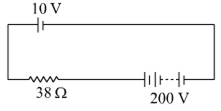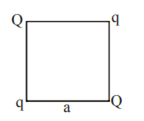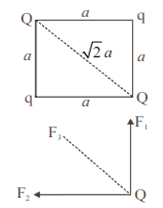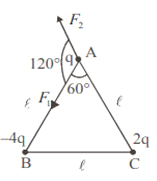CBSE physics
Sponsor Area
Two electric bulbs P and Q have their resistances in the ratio of 1: 2. They are connected in series across a battery.Find the ratio of the power dissipation in these bulbs.
Let ratio be x
Rp = x (Resistance of bulb P)
Rq = 2x (Resistance of bulb Q)
We know, P = VI = V.V/R
Sponsor Area
A 10 V cell of negligible internal resistance is connected in parallel across a battery of emf 200 V and internal resistance 38 Ω as shown in the figure. Find the value of current in the circuit.

The positive terminals are connected to the offsite ends of the resistor, they send the current in opposite directions.
Hence, the net emf = 200-10 = 190 V
∴ current in the circuit I = E/R
= 190V / 38 Ω
= 5 A
In a potentiometer arrangement for determining the emf of a cell, the balance point of the cell in open circuit is 350 cm. When a resistance of 9 ohm is used in the external circuit of the cell, the balance point shifts to 300 cm. Determine the internal resistance of the cell.
Potentiometer at open circuit ℓ1 = 350
R = 9
ℓ2 = 300
Four point charges Q, q, Q and q are placed at the corners of a square of side ‘a’ as shown in the figure

Find the
(a) resultant electric force on a charge Q,
(b) the potential energy of this system.

F1 and F2 are perpendicular to each other so their resultant will be
F3 and resultant of F1 and F2 will be in the same direction
Net force
F = F' + F3
(b) The potential energy of the given system,
Three point charges q, – 4q and 2q are placed at the vertices of an equilateral triangle ABC of side ‘l’ as shown in the figure. Obtain the expression for the magnitude of the resultant electric force acting on the charge q.

(b) Find out the amount of the work done to separate the charges at infinite distance.

(b) The amount of work done to separate the charges at infinity will be equal to potential energy.
Sponsor Area
Mock Test Series
Mock Test Series





